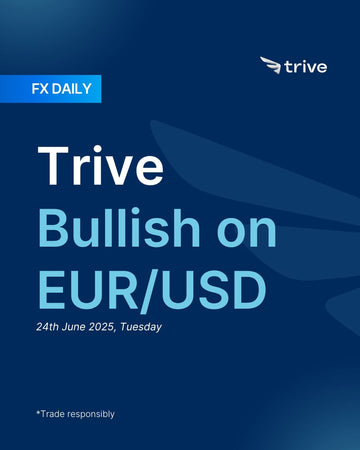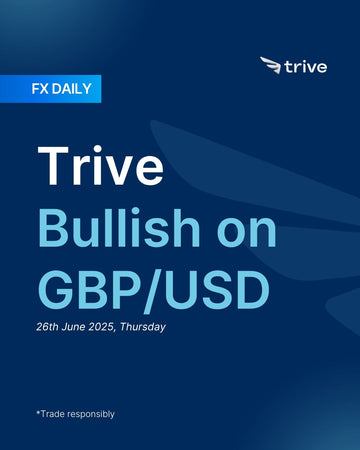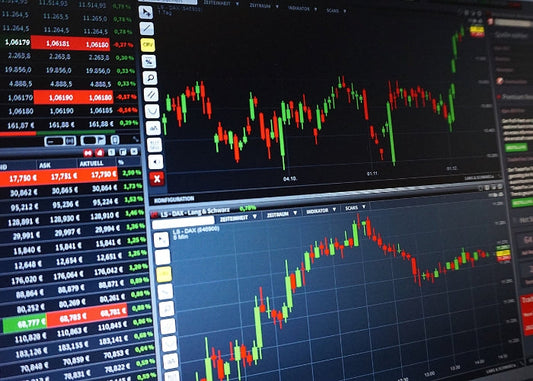FX Daily: Trive Bullish on GBP/USD

The strong GBP underpinned by the UK’s political stability, limited exposure to tariffs and global trade tensions, robust macroeconomic data, and strong hedge-fund positioning. On the other hand, the Dollar will weaken as investors shift capital away from US assets over time.
USD: Don’t get fool!
The US Dollar climbed sharply this week, becoming the main safe haven asset as tensions in the Middle East escalated and the Federal Reserve took a hawkish tone. The DXY jumped from near 97.68 to break above 99.00 as fears of direct US military action in the Israel Iran conflict took over market sentiment. The mood turned more cautious midweek after aggressive statements from President Trump and reports that he was seriously considering strikes on Iranian nuclear sites. This geopolitical flight to safety was intensified by the Federal Reserve’s meeting on Wednesday. Although the Fed kept rates unchanged and maintained its projection of two cuts in 2025, internal dynamics shifted in a hawkish direction. The Fed raised its inflation forecasts and lowered growth expectations, signaling a firm commitment to a restrictive policy stance. Chair Jerome Powell, in his press conference, emphasized patience and dismissed the possibility of near term cuts, which further strengthened the dollar. Toward the end of the week, a slight deescalation occurred when Trump announced a two week window for diplomacy. The dollar gave back some gains but still ended the week much stronger, as both geopolitical risk and central bank policy reaffirmed its safe haven appeal.
On the economic data front, May’s retail sales figures were mixed. The headline number missed expectations with a 0.9% drop, but the control group figure used in GDP calculations came in stronger at +0.4%. Meanwhile, housing data showed signs of weakness, with May housing starts down by 9.8% and building permits falling 2.0%. Regional manufacturing surveys added to concerns about a slowdown. The New York Fed’s manufacturing index dropped to 16.0, well below expectations, and the Philadelphia Fed’s index remained negative at 4.0, with its employment component falling to its lowest since May 2020. Labor market data also suggested a gradual loosening. Weekly initial jobless claims stayed elevated at 245,000, and the four week average rose to its highest since August 2023.
From a policy standpoint, the Fed’s decision to hold rates was expected, but the details revealed a more hawkish tone. The updated Summary of Economic Projections kept the median 2025 forecast at 50 basis points of cuts. However, more members now projected no cuts at all this year, up from four in March to seven. Inflation forecasts for 2025 and 2026 were revised higher, and GDP expectations were lowered, partly due to concerns over the inflationary effects of tariffs. Powell’s press conference reinforced a cautious approach, describing policy as only “modestly restrictive” and underlining the need to wait and see how tariffs play out before making any decisions. Following the Fed’s blackout period, Fed Governor Waller, a known dove, suggested rate cuts could come as early as July. This clashed with Powell’s more reserved stance but did lead markets to price in slightly more easing by the end of the year. Richmond Fed President Barkin took a more conservative view, saying there was “no rush to cut rates.”
Geopolitical developments were the key force behind the dollar’s rally. Concerns about an escalation between Israel and Iran intensified on Tuesday and Wednesday, especially as reports surfaced that Trump was holding security council meetings and weighing US military action on Iran’s Fordow nuclear site. His rhetoric further spooked markets, including calls for Tehran’s evacuation and claims of US control over Iranian airspace. However, the tone shifted slightly by the end of the week. Trump announced he would delay any decision for two weeks, allowing room for diplomacy. Reports also indicated that Iran was open to discussing limits on uranium enrichment with European countries, which helped ease some of the market’s immediate concerns and pulled the dollar back from its highs.
The US Dollar has recently reacted in a more typical way, strengthening after geopolitical tensions and a hawkish Fed meeting. This shows that the Dollar still acts as a safe haven in uncertain times, and we see some upside potential in the short term.
However, our overall view is bearish. Over time, we believe the Dollar will weaken as investors shift capital away from US assets. So, while short-term gains are possible, especially if risk-off events continue, we see these rallies as opportunities to sell the Dollar—particularly when it becomes overbought.
GBP: Still supported
The British Pound spent the week pulled between a major trade deal, a more dovish shift from the Bank of England, and surprisingly weak domestic data. However, its performance was ultimately shaped by the broader strength of the US Dollar. Sterling started off on a strong note, testing the 1.3600 level on optimism around a pending US UK trade agreement. The deal was officially signed on Tuesday and provided some initial support. But as the week went on, sentiment turned. On Thursday, the Bank of England delivered a dovish surprise when Deputy Governor Dave Ramsden joined two others in voting for an immediate rate cut. That was followed by a dismal May retail sales report on Friday, which pointed to deep weakness in consumer spending. Despite these negative domestic developments, the Pound didn’t collapse. Instead, it gradually lost ground, dragged down by the global shift into the US Dollar as a safe haven during the heightening Middle East tensions. GBP/USD fell through 1.3500 and closed near its weekly lows, with the Pound’s direction largely determined by external risk sentiment rather than UK specific news.
Economic data played a key role in the narrative. Friday’s retail sales report was the most striking, with sales plunging by 2.7 percent month over month, far worse than the expected 0.5 percent. The decline was broad based, signaling notable weakness in consumer demand. Yet the initial selloff in Sterling was surprisingly short lived. Earlier in the week, May’s inflation data came in mostly in line with expectations. Headline CPI held steady at 3.4 percent year over year, while core inflation eased slightly to 3.5 percent. The services inflation figure, a key input for the Bank of England, came in just below expectations at 4.7 percent, subtly backing the case for the more dovish voices within the bank. Additionally, the UK’s public borrowing numbers showed rising fiscal stress, with May’s public sector net borrowing figure marking the highest ever for the month outside of the pandemic years.
From a policy perspective, the Bank of England kept rates unchanged at 4.25 percent, as expected. However, the surprise came in the vote split. It was 6 to 3, with Dave Ramsden unexpectedly siding with Dhingra and Taylor in calling for a 25 basis point cut. This added to the sense that the BoE is shifting more clearly toward easing. Despite that shift, the Monetary Policy Committee kept its “gradual and careful” guidance, and Governor Bailey emphasized that this shouldn’t be interpreted as a commitment to cut rates in August. Still, the market reaction was muted, which showed that traders were paying more attention to the broader global backdrop than to internal Bank of England dynamics.
Last week’s main positive development for the Pound was the signing of the US UK trade agreement. The deal covers key sectors like beef, steel, autos, and ethanol. However, the announcement came with a notable caveat, the US will keep its 25 percent tariff on UK steel in place “for now,” which dampened some of the enthusiasm. Still, the agreement helped provide some support for the Pound and likely prevented a steeper decline.
In terms of market sentiment, the Pound’s movements reflected global risk flows rather than domestic factors. The strength of the US Dollar, driven by safe haven demand and a hawkish Federal Reserve, overwhelmed the Pound’s own story. The reaction to both the BoE’s dovish shift and the weak retail sales report was subdued, signaling that markets were more focused on the geopolitical risks and broader dollar dynamics. Instead of reacting sharply to UK specific events, the Pound drifted lower throughout the week, shaped by the dominant trend in global sentiment.
Our baseline bias remains bullish on the British pound, underpinned by the UK’s political stability, limited exposure to tariffs and global trade tensions, robust macroeconomic data, and strong hedge-fund positioning. However, the ongoing conflict between Iran and Israel may drive a preference for traditional safe havens such as the Swiss franc and Japanese yen; even so, sterling should hold up better than currencies like the Australian and New Zealand dollars.

GBP/USD 4H
Disclaimer
This material is provided for informational purposes only and does not constitute financial, investment, or other advice. The opinions expressed in this material are those of the author and do not necessarily reflect the views of Trive International. No opinion contained in this material constitutes a recommendation by Trive International or its author regarding any particular investment, transaction, or investment strategy. This material should not be relied upon in making any investment decision.
The information provided does not consider the individual investment objectives, financial situation, or needs of any specific investor. Investors should seek independent financial advice tailored to their individual circumstances before making any investment decisions. Trive International shall not be liable for any loss, damage, or injury arising directly or indirectly from the use of this information or from any action or decision taken as a result of using this material.
Trive International may or may not have a financial interest in the companies or securities mentioned. The value of investments may fluctuate, and investors may not get back the amount they originally invested. Past performance is not indicative of future results.
For more information about Trive International, please visit http://trive.com/int
Additional Information
Investing involves risk, including the potential loss of principal. Diversification and asset allocation strategies do not ensure a profit or guarantee against loss. The content in this material is subject to change without notice and may become outdated or inaccurate over time. Trive International does not undertake any obligation to update the information in this material.
By accessing this material, you acknowledge and agree to the terms of this disclaimer. If you do not agree with these terms, please refrain from using this information.
No comments
Home
Trive
TriveHub





0 comments